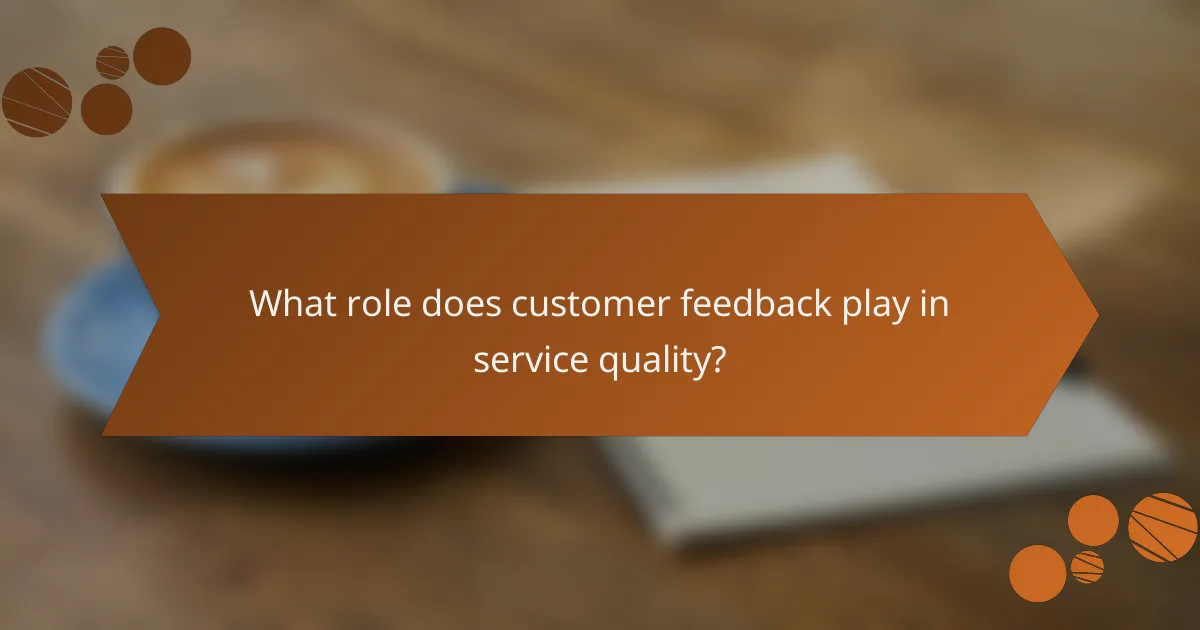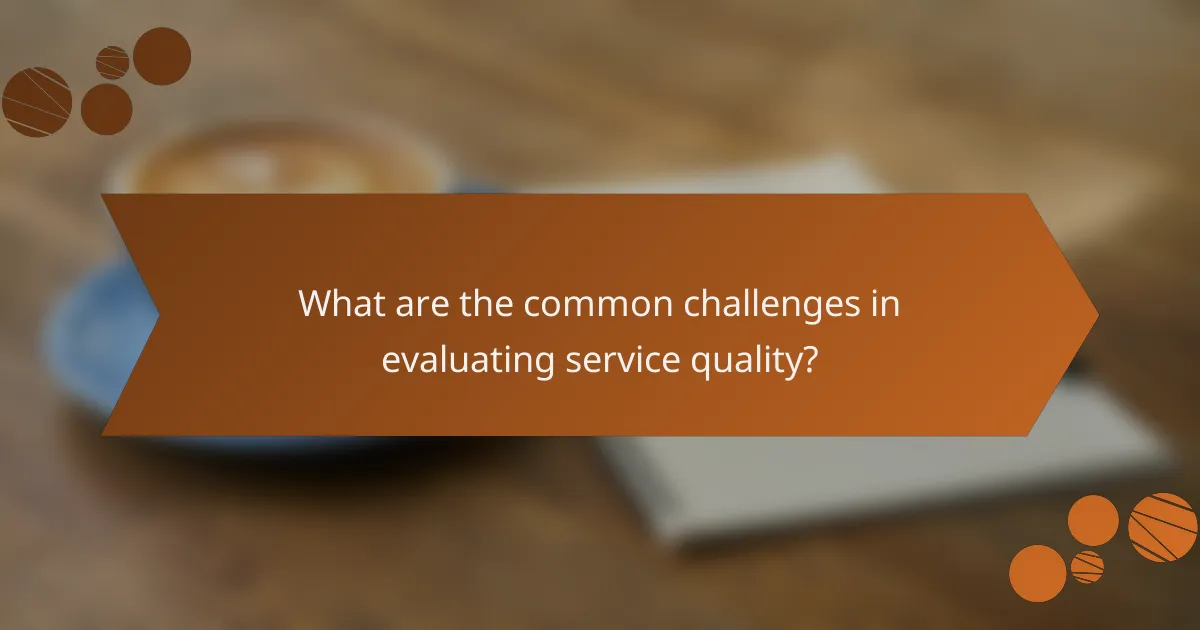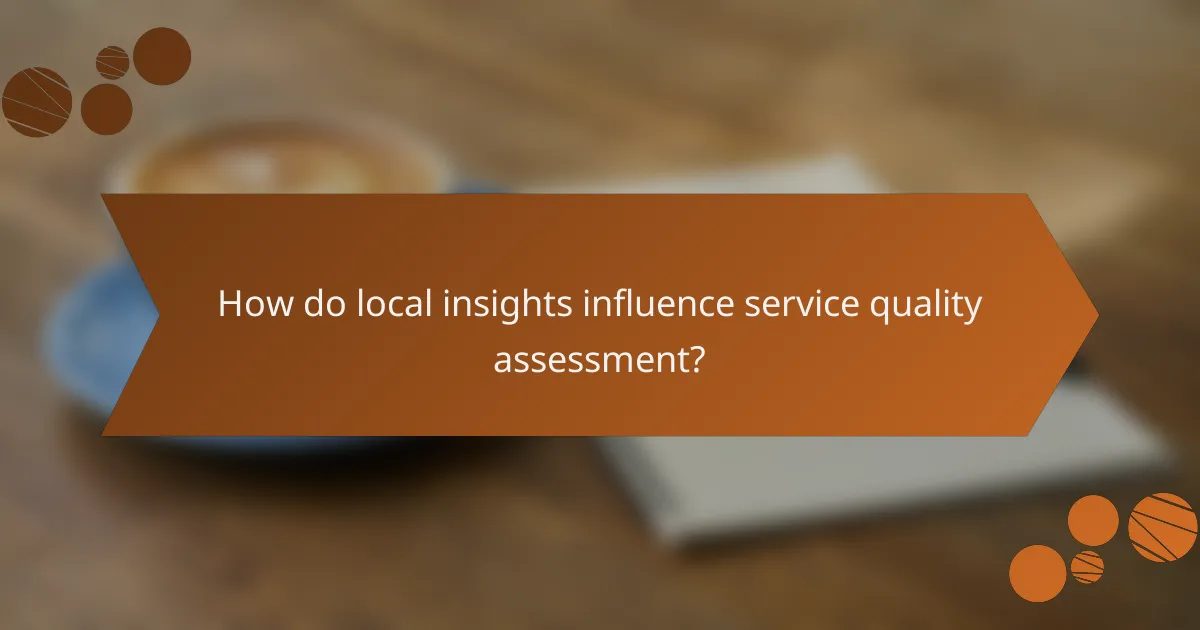Evaluating service quality in local businesses is crucial for enhancing customer experience and satisfaction. By identifying performance indicators and gathering customer feedback, businesses can gain valuable insights into customer expectations and areas for improvement. Utilizing multiple channels for feedback collection ensures a well-rounded understanding of customer experiences, enabling informed decision-making to elevate service quality.

How to evaluate service quality in local businesses?
Evaluating service quality in local businesses involves assessing various factors that contribute to customer experience. Key methods include identifying performance indicators, gathering customer feedback, and measuring service consistency.
Key performance indicators
Key performance indicators (KPIs) are quantifiable metrics that help assess service quality. Common KPIs include response time, resolution rate, and customer retention rate. For local businesses, tracking these metrics can reveal areas needing improvement.
For instance, a restaurant might measure the average time taken to serve a meal, while a retail store could track the number of repeat customers over a specific period. Establishing benchmarks for these KPIs can guide businesses in setting realistic goals.
Customer satisfaction surveys
Customer satisfaction surveys are essential tools for gathering direct feedback from clients about their experiences. These surveys can be conducted online or in-person and typically include questions about service quality, staff friendliness, and overall satisfaction.
Local businesses should aim for a response rate of at least 20-30% to ensure the feedback is representative. Offering incentives, such as discounts or loyalty points, can encourage more customers to participate in these surveys.
Service consistency metrics
Service consistency metrics evaluate how reliably a business delivers its services over time. This can include tracking the uniformity of service delivery, such as the quality of food at a café or the accuracy of orders in a retail environment.
To measure consistency, businesses can conduct regular audits or mystery shopper programs. Maintaining high consistency can significantly enhance customer loyalty, as clients appreciate knowing what to expect during each visit.

What role does customer feedback play in service quality?
Customer feedback is essential for enhancing service quality as it provides direct insights into customer experiences and expectations. By understanding what customers value and where they face challenges, businesses can make informed decisions to improve their offerings.
Direct impact on service improvement
Customer feedback directly influences service improvement by identifying strengths and weaknesses in service delivery. For instance, if multiple customers report long wait times, a business can prioritize staffing adjustments or process changes to address this issue. Regularly analyzing feedback helps organizations adapt and refine their services to better meet customer needs.
Additionally, implementing changes based on feedback can lead to increased customer satisfaction and loyalty. When customers see their suggestions taken seriously, they are more likely to engage positively with the brand.
Feedback channels and tools
Various channels and tools can be utilized to gather customer feedback effectively. Surveys, online reviews, and social media platforms are common methods for collecting insights. For example, businesses can use tools like SurveyMonkey or Google Forms to create targeted surveys that capture specific aspects of service quality.
Moreover, integrating feedback tools into customer interactions, such as post-purchase surveys or in-app feedback options, can streamline the process and encourage more responses. It’s crucial to ensure that these channels are easily accessible and user-friendly to maximize participation.
Case studies of successful feedback implementation
Several companies have successfully leveraged customer feedback to enhance their service quality. For instance, a well-known hotel chain implemented a feedback system that allowed guests to rate their stay in real-time. This immediate feedback enabled the staff to address issues promptly, resulting in a significant increase in customer satisfaction ratings.
Another example is a popular restaurant that used customer feedback to revamp its menu. By analyzing reviews and suggestions, the restaurant introduced new dishes that aligned with customer preferences, leading to a noticeable uptick in repeat visits and positive online reviews.

What are the best practices for gathering customer feedback?
Effective customer feedback gathering involves using multiple channels to capture insights from various perspectives. Best practices include leveraging online platforms, in-person interactions, and social media to ensure a comprehensive understanding of customer experiences.
Online review platforms
Online review platforms are essential for collecting customer feedback, as they provide a space for customers to share their experiences publicly. Popular platforms like Google Reviews, Yelp, and TripAdvisor allow businesses to monitor sentiments and respond to feedback, enhancing customer engagement.
To maximize the effectiveness of these platforms, encourage satisfied customers to leave positive reviews and promptly address any negative feedback. This not only improves your online reputation but also demonstrates your commitment to customer satisfaction.
In-person feedback collection
In-person feedback collection can yield rich insights, as it allows for direct interaction with customers. This can be done through surveys, suggestion boxes, or informal conversations during service encounters. Engaging customers face-to-face often leads to more detailed and candid responses.
When collecting feedback in person, ensure that staff are trained to ask open-ended questions and actively listen. This approach can help uncover specific areas for improvement and foster a sense of trust between the customer and the business.
Utilizing social media for insights
Social media platforms are valuable tools for gathering customer feedback and insights. By monitoring comments, messages, and mentions on platforms like Facebook, Twitter, and Instagram, businesses can gain real-time feedback on their products and services.
To effectively utilize social media, actively engage with customers by responding to their inquiries and comments. Additionally, consider running polls or surveys through these channels to gather structured feedback, which can inform future business decisions.

How can local businesses respond to customer feedback?
Local businesses can effectively respond to customer feedback by implementing structured strategies that prioritize timely communication, personalized interactions, and actionable changes. Addressing feedback promptly not only enhances customer satisfaction but also fosters loyalty and trust.
Timely response strategies
Responding to customer feedback quickly is crucial for maintaining a positive relationship. Aim to acknowledge feedback within a few hours and provide a more detailed response within one to three business days. This shows customers that their opinions are valued and taken seriously.
Utilizing automated tools can help streamline this process. For instance, setting up automated email replies or chatbots can ensure that customers receive immediate acknowledgment while you prepare a more personalized response.
Personalized communication techniques
Personalization in communication can significantly enhance customer engagement. Use the customer’s name and reference specific details from their feedback to create a more tailored response. This approach demonstrates that you are genuinely interested in their experience.
Consider employing various channels for communication, such as email, social media, or direct phone calls, depending on the customer’s preference. This flexibility can lead to more meaningful interactions and a stronger connection with your clientele.
Implementing changes based on feedback
Acting on customer feedback is essential for continuous improvement. After collecting and analyzing feedback, prioritize changes that align with common themes or issues raised by multiple customers. This targeted approach can lead to more effective enhancements.
Communicate the changes made as a result of customer feedback to your audience. This transparency not only builds trust but also encourages further feedback, creating a cycle of improvement. For example, if customers frequently mention a need for extended hours, consider adjusting your operating schedule accordingly.

What are the common challenges in evaluating service quality?
Evaluating service quality presents several challenges that can hinder accurate assessment. Key issues include difficulties in data collection, interpreting feedback accurately, and managing negative reviews effectively.
Data collection difficulties
Collecting data on service quality can be problematic due to various factors such as limited response rates and biased feedback. Many customers may not take the time to provide input, leading to incomplete data that does not represent the broader customer experience.
To improve data collection, businesses should consider multiple channels for feedback, such as surveys, social media, and direct interviews. Offering incentives for participation can also boost response rates and yield more comprehensive insights.
Interpreting feedback accurately
Interpreting customer feedback accurately is crucial yet challenging, as feedback can be subjective and influenced by individual experiences. Different customers may have varying expectations, making it difficult to gauge overall service quality from qualitative comments.
To enhance interpretation, organizations should categorize feedback into themes and look for patterns over time. Utilizing sentiment analysis tools can also help quantify emotions expressed in reviews, providing a clearer picture of customer satisfaction.
Managing negative reviews
Negative reviews can significantly impact a business’s reputation, making it essential to manage them effectively. Responding promptly and professionally to negative feedback can demonstrate a commitment to customer satisfaction and help mitigate potential damage.
Businesses should develop a strategy for addressing negative reviews, including acknowledging the issue, offering solutions, and inviting further dialogue. This proactive approach can turn dissatisfied customers into loyal advocates and improve overall service quality perception.

How do local insights influence service quality assessment?
Local insights play a crucial role in evaluating service quality by reflecting the specific needs and preferences of a community. Understanding these insights allows businesses to tailor their services effectively, ensuring higher customer satisfaction and loyalty.
Understanding community expectations
Community expectations are shaped by cultural norms, local values, and historical experiences. Businesses must recognize that what is considered acceptable service in one region may differ significantly in another. For instance, a fast response time might be prioritized in urban areas, while rural communities may value personal interaction more highly.
To effectively gauge community expectations, businesses can engage in direct conversations with customers, conduct surveys, or analyze online reviews. This feedback can highlight specific areas for improvement and help identify service features that resonate with local clientele.
Additionally, businesses should monitor competitors within the area to understand prevailing service standards. By comparing offerings and customer feedback, companies can pinpoint gaps in their service quality and adapt accordingly to meet or exceed local expectations.
